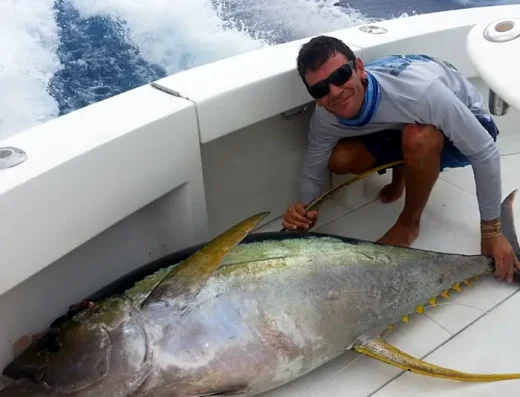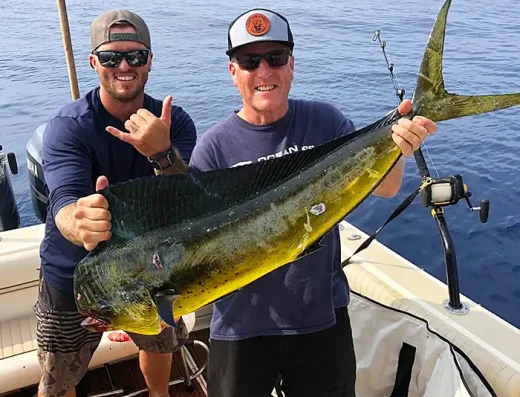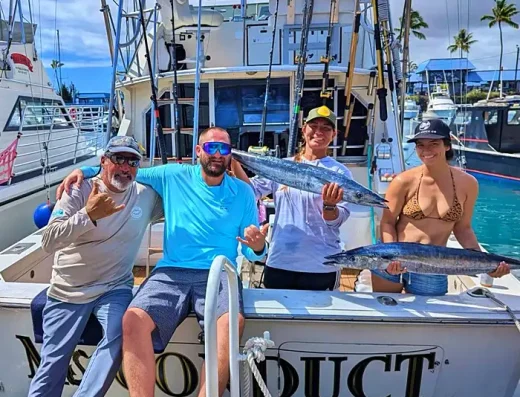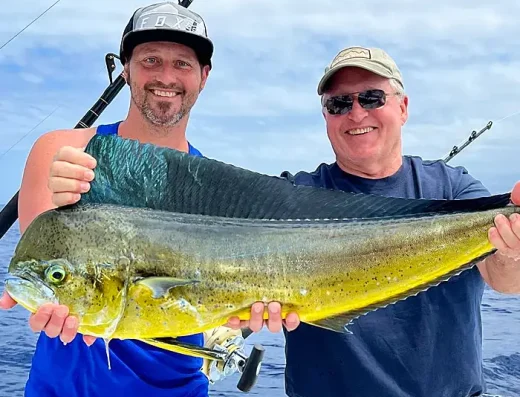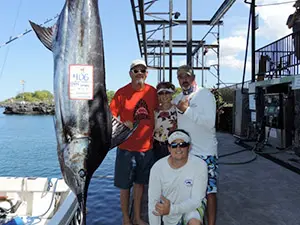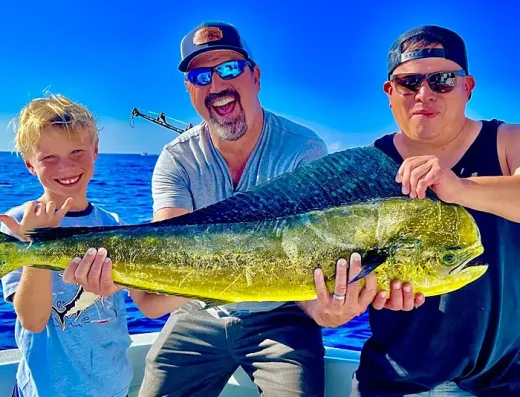Big Island Charter Fishing
Big Island fishing charters push into Kona’s calm bluewater drop-offs, Hilo’s offshore FADs, and rugged southern ledges for blue marlin, ahi tuna, mahi mahi, ono, spearfish, trevally, and deepwater snapper.
TrustedFish connects anglers with proven local captains in Big Island, Hawaii —no commissions, no pay-to-play listings, no BS. Every charter on our platform is invite-only, vetted for skill, local knowledge, and reputation. If they’re listed, they’ve earned it.
Top Rated Big Island Charterss
Big Island, HI Fishing Guide
The Big Island is Hawaii’s largest and most diverse fishery, with different coasts offering distinct opportunities depending on conditions, harbor access, and season. Nowhere else in the state has the same combination of calm water, short run distances, and access to grander-class marlin. Kona is the heart of it all — sheltered from prevailing tradewinds by Mauna Loa and Mauna Kea, the leeward coast has glassy conditions most days of the year. Just outside Honokohau Harbor, captains are trolling in 1,000 fathoms of water within minutes, meaning even half-day trips put anglers in prime territory. That short distance to deep water is why Kona is one of the most famous big-game ports in the world.
Charters here range from 4-hour quick runs to the ledges for ono and mahi, to 10-hour tournament days chasing blue marlin. Some boats specialize in heavy trolling spreads for billfish, running five to seven skirted lures in varied positions and colors to cover different depths and bait profiles. Others mix in live baiting at FADs, dropping bridled skipjack or aku to entice ahi and marlin that mark on sonar but won’t rise to the lures. Deep dropping with electric reels for snapper and grouper is offered as well, usually when offshore seas are rougher in winter. Nearshore reef fishing is less common on the Big Island than on smaller islands, but some captains do jig or bait fish for trevally, barracuda, and smaller snappers inshore.
Beyond Kona, the island has multiple productive regions. Hilo on the east side is rougher but offers access to offshore FADs and seamounts. Kawaihae and Waikoloa on the northwest coast serve the resort corridor, with quick access to tuna and mahi grounds. South Point is raw and current-swept, drawing ono and tuna when the weather allows. The North Kohala coast has quieter waters and fewer boats, appealing to anglers seeking a less crowded experience.
Seasonality shapes tactics. Spring brings mahi and ono close, summer is the heart of big-game season with grander marlin and 100-pound ahi dominating spreads, fall offers a balanced mixed bag with calm weather and lighter traffic, and winter shifts to striped marlin, spearfish, and bottom fish. Tournament season in June, July, and August is a spectacle in Kona, with fleets from around the Pacific chasing records. Year-round, the Big Island is the most consistent place in Hawaii to chase bluewater pelagics, with the advantage of short runs and calm seas that make fishing possible nearly every day of the year.
Big Island Fishing Seasons
Spring (March–May)
Summer (June–August)
Summer is the Big Island’s showcase. This is when giant blue marlin push into Kona waters, with many fish over 500 lbs and the occasional grander topping 1,000 lbs. Yellowfin tuna (ahi) are at their thickest, often feeding under bird piles and marking deep on sonar. Captains troll heavy spreads and switch to live baiting when tuna are stubborn. Ono remain consistent, and mahi are still available offshore. Tournament season fills the harbor, and boats often fish dawn to dusk. Seas are glassy, and long full-day trips are the norm.
Fall (September–November)
Fall keeps tuna and marlin in play but with lighter traffic on the water. Mahi mahi fishing improves again, especially in October, with fish holding on current lines and debris. Spearfish begin appearing, and ono remain active into early fall. Weather is stable, seas stay calm, and anglers often enjoy a balance of pelagics without the summer tournament crowds.
Winter (December–February)
Winter brings cooler water and a shift in species. Striped marlin and shortbill spearfish become primary targets, with occasional blue marlin still taken. Tuna are smaller on average but still caught around FADs. Rougher conditions affect Hilo and the east side, but Kona’s leeward waters stay fishable most days. Bottom fishing grows popular in this season, with deepwater snapper, grouper, and trevally providing steady action. Humpback whales are a daily sight offshore, adding to the experience.
Top Fishing Regions
Kona Coast (Honokohau Harbor)
This is the undisputed capital of Hawaiian sportfishing. Honokohau Harbor lies just north of Kailua-Kona and serves as the home base for dozens of professional charter boats. The unique underwater structure off Kona drops from shallow lava shelves into thousands of feet almost instantly, so captains are setting lines within five minutes of leaving the dock. This accessibility is unmatched anywhere else in Hawaii. The area is also the calmest in the islands, allowing anglers to target blue marlin, ahi, ono, and mahi in comfort year-round. Tournament fishing is centered here, and nearly every record marlin in Hawaii has been weighed in Kona.
Hilo Bay and Offshore East Side
On the windward side, Hilo has a different feel. The harbor is more exposed to tradewinds, and seas can be rougher, but offshore FADs and seamounts produce tuna, mahi, and billfish. Many captains run 10–15 miles to reach the buoys, then troll or live bait around them. Closer in, reefs and drop-offs hold trevally, snapper, and barracuda, making Hilo a good choice for mixed-bag trips. Anglers fishing out of Hilo often see fewer boats than Kona, giving a more solitary experience.
Kawaihae and Waikoloa (Northwest Coast)
These ports serve the Kohala Coast resort corridor, making them popular with visiting anglers who want a short drive from their hotel. Boats here have excellent access to tuna and mahi grounds, often trolling north toward Kohala or west into deep water. Seas are generally calmer than Hilo but not as consistently flat as Kona. This side of the island is excellent for families staying in resorts who still want access to offshore pelagics.
South Point (Ka Lae)
The southernmost tip of the United States is raw, rugged, and current-swept. Waters here are often too rough for regular charters, but when the weather allows, South Point is known for ono stacked on the ledges and tuna feeding along current breaks. This is not a place for beginners, but seasoned anglers who time the weather right can see incredible fishing.
North Kohala Coast
Farther north, Kohala has fewer boats and less pressure. The steep underwater shelves off this coast hold mahi, marlin, and spearfish, and trips here often see less boat traffic compared to Kona. This region appeals to anglers looking for a quieter charter and a chance at unique species with less competition
Kealakekua and Captain Cook Area
While not as busy as Kona Harbor, the waters south of Kailua-Kona have productive shelves and reef systems. Ono and trevally are common, and some captains offer combination trips that fish offshore in the morning and target reef fish in the afternoon. This region is less known but can offer steady action with scenic backdrops.
Top Big Island Gamefish
- Blue Marlin – 200 to 1,000 lb. Found offshore in Hawaii, Gulf Stream, and deep Pacific canyons; best summer months; trolling large lures or skip baits.
- Yellowfin Tuna (Ahi) – 30–200 lbs. Peak June–August, found around FADs and seamounts. Targeted trolling, live baiting, or chunking.
- Wahoo (Ono) – 20–50 lbs. Peak in spring and summer, hit high-speed trolling lures along coastal ledges.
- Mahi Mahi – 15–40 lbs. Strong in spring and fall, taken under rips, debris, and FADs offshore.
- King Mackerel – 10 to 50 lb. Gulf and Southeast Atlantic; best in cooler months; trolling spoons and live bait.
- Striped Marlin – 40–120 lbs. Winter catch, best Dec–Feb, hooked trolling east and west coasts.
- Shortbill Spearfish – 20–60 lbs. Found winter and spring, taken trolling smaller lures offshore
- Giant Trevally (Ulua) – 10–80 lbs. Found around reefs and channels, best with jigs and live bait.
- Deepwater Snapper (Onaga, Opakapaka) – 2–15 lbs. Taken on deep bottom rigs and electric reels on lava slopes.
Big Island Fishing FAQs
Where do most charters leave from on the Big Island?
Honokohau Harbor in Kona is the main port, with dozens of boats fishing daily. Hilo, Kawaihae, and South Point also have charters, but Kona remains the core of the fishery.
How long are typical fishing trips?
Half-day trips last 4–6 hours and fish nearby ledges, FADs, or reef edges. Full-day charters run 8–10 hours, chasing marlin and tuna offshore at seamounts and current lines.
What gear is provided?
All charters supply heavy trolling tackle, lures, and bait. Specialty bottom fishing trips include electric reels and deep-rig setups for snapper.
Do anglers need a fishing license?
No recreational saltwater license is required in Hawaii. Charter permits cover all guests on board.
What’s the best season to fish the Big Island?
Summer is prime for giant marlin and ahi, spring and fall are excellent for mahi and ono, and winter is best for striped marlin, spearfish, and bottom fishing.
What techniques are used?
Trolling is the backbone offshore. Crews also use live baiting around FADs, high-speed trolling for ono, and deep dropping with electric reels for snapper and grouper.
What can I expect on a half-day Kona charter?
Mahi, ono, and smaller ahi are common, and marlin are possible even close to shore. Half-day trips are productive because deep water starts almost immediately outside the harbor
How many anglers can join a trip?
Most Kona boats comfortably take 4–6 anglers. Larger sportfishers can accommodate bigger groups, but always confirm capacity before booking.
Are bottom fishing trips available?
Yes, some captains specialize in deep dropping for onaga and opakapaka snapper, as well as reef trips for trevally and jacks. These trips are popular in winter when seas offshore can be rougher.

